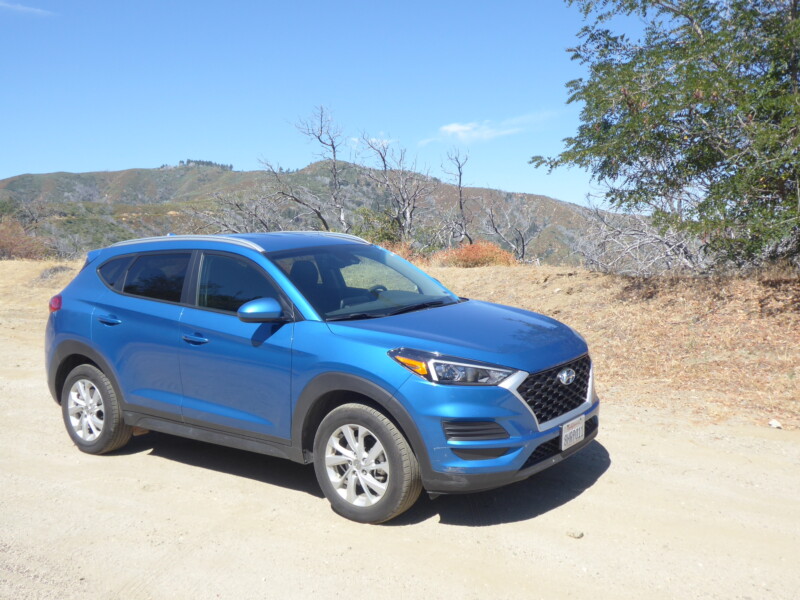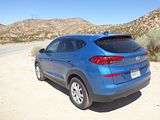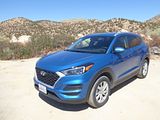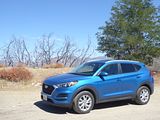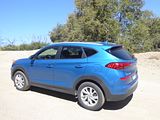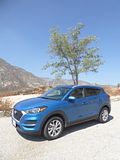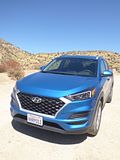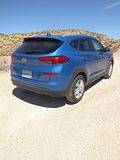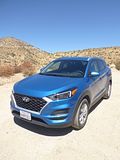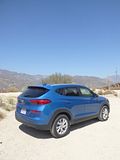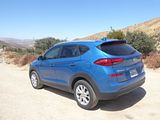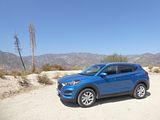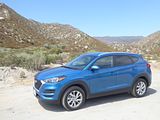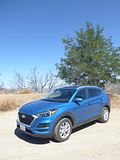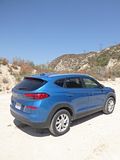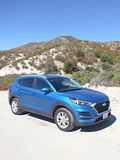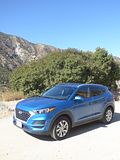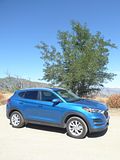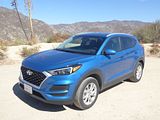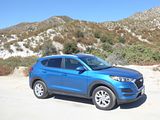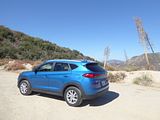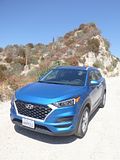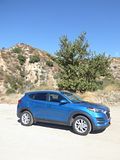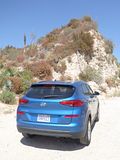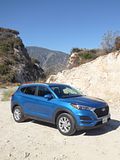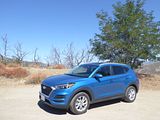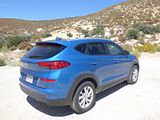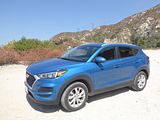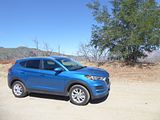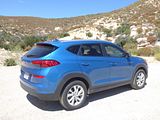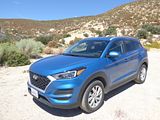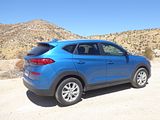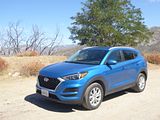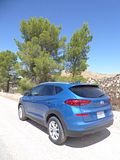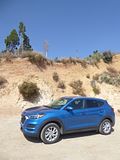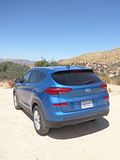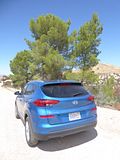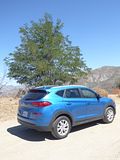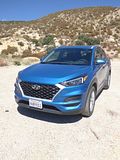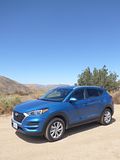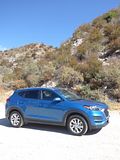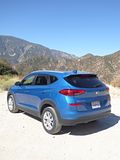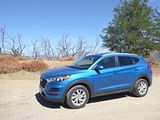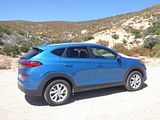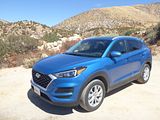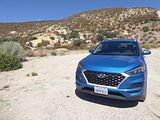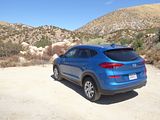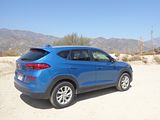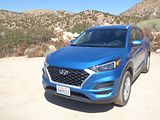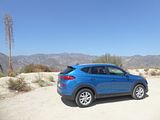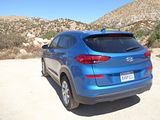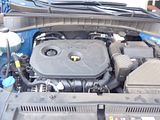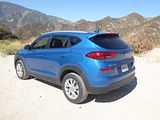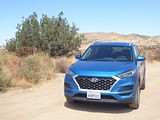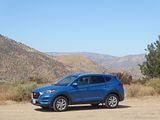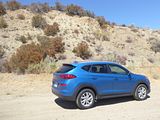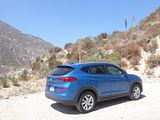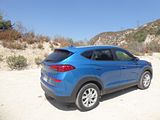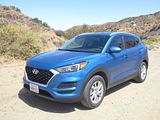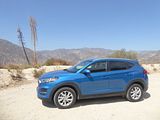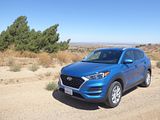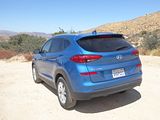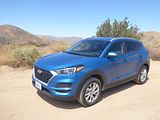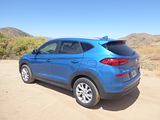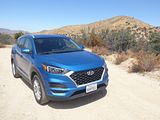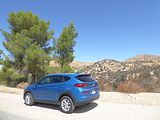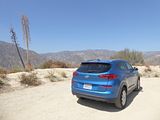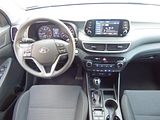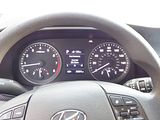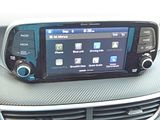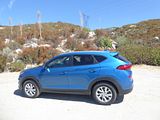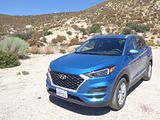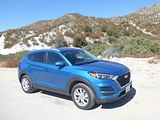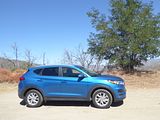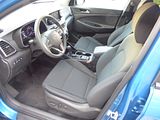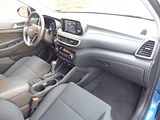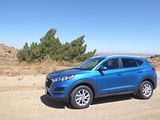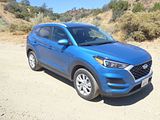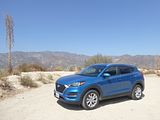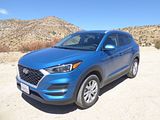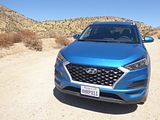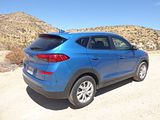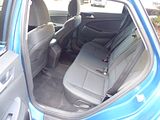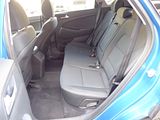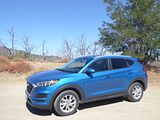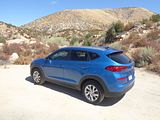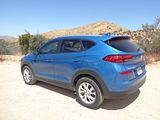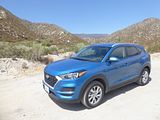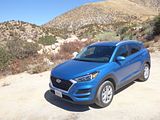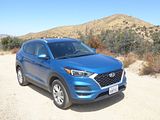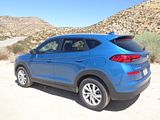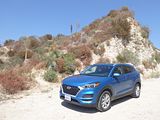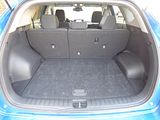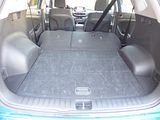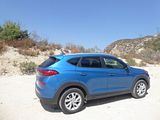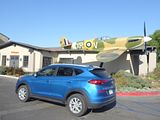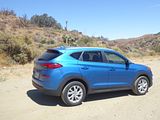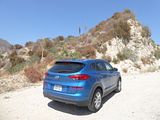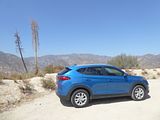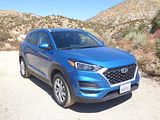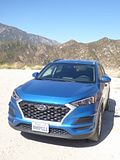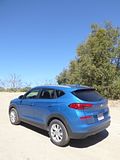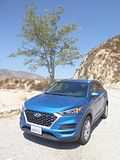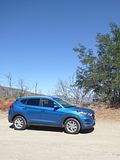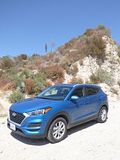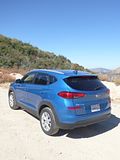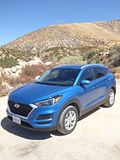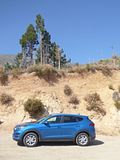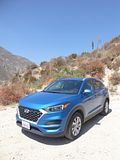The Tucson is Hyundai’s entrant in the mid-sized Crossover class, and as such it is an extremely important vehicle for the Korean brand, with its sales in most markets now comfortably eclipsing those of the Elantra and Sonata sedans. It is on its third generation, having started out back in 2005 looking very much like a shrunken version of the larger Santa Fe, and then replaced in the autumn of 2009 by a second generation model which in Europe and most of the rest of the world was rechristened the ix35 in line with a new naming strategy which was never manifest in the New World. This car made more of an impact than the first one had done, partly because that is simply the way the market was moving and also because it was a rather better product. I finally got to sample one, from Hertz in Los Angeles right at the end of its production cycle when suddenly a number of them appeared on fleet, after never having been available since introduction. The one I had was on Texas plates, and I recall taking it, as the first one I had seen, only to discover on subsequent days that there were plenty more of them then available. It was a decent enough offering, but this market sector was evolving fast and given the pace at which the Koreans refresh all their cars – on average around every 5 years – it was no surprise when a third generation Tucson was launched at the 2015 Geneva Show, going on sale around the world later that year, and this time known everywhere as the Tucson again. Hertz did acquire some of these almost immediately, and it was always on my list of vehicles to try, but after a while I realised that the model had all but disappeared from fleet. There was then a period when almost all other Hyundai models also went, the result, I gathered at the time, of complaints at there being nothing but a sea of them in other vehicle classes, though I suspect the reality is more likely to be based around discounts available versus what other manufacturers were offering. During my March 2019 trip to the US, I noticed a couple of Tucson models parked up, on out of State plates, but never managed to source one. Believing them still to be hard to get hold of, when I arrived in Los Angeles in September 2019 for a couple of weeks vacation, when I spotted one available in the rather attractive bright blue colour that Hyundai call Aqua Blue, I took it, only to discover every day after that, that in fact there are currently plenty of them on fleet. Never mind, this was in the colour I liked the best, so apart from a little frontal damage which is not too evident in the pictures, it was a great choice for seeing just what the Tucson is like now.
The Tucson of 2019 is almost certainly in the later stages of its current generation, with scoop photos of a next generation car having been published during the summer of 2019. It underwent its mid-cycle update with a facelifted version shown at the 2018 New York Auto Show, with the revised cars available for the 2019 model year, though, suggesting it could have a while to run yet. Most of those changes appear quite subtle, and it will take a trained eye to spot them, but they were in fact quite extensive. Exterior updates included a new cascade grille, reshaped bonnet and tailgate design, a rectangular fuel door, new wheel rim designs, and an updated LED headlight design for higher trim levels. The interior received a major update to include a newly designed dash with lower centrally-placed air vents and a high-mounted infotainment unit display. A new safety feature named Driver Attention Warning (DAW) system became standard across all trim levels, and both the Lane Keeping Assist (LKA) departure/correction system and Front Collision Avoidance Assist (FCA) system were also standardised across all trim levels. The manual and dual clutch transmission options were dropped in favour of the 6-speed Shiftronic automatic used in previous model years, available with Front- or All-Wheel-Drive. The 2.0 litre Nu GDI engine continued in the SE and Value trim levels but for other trims the 1.6 litre Turbo engine was dropped and replaced by a 2.4 litre GDI naturally aspirated engine, producing 181 bhp with a slight loss in fuel economy. It was one of these 2019 model year cars that I received.
As with most cars these days, there is no badging on the outside to indicate which model version you’ve got, or the engine fitted, and a look under the bonnet is rarely much help, either. I could tell that there are 4 cylinders, but then all Tucson models currently come with that configuration, so was none the wiser. Having driven the Tucson for a day, I also concluded that the car seemed disappointingly underpowered. Indeed, it was positively sluggish at times, with the engine seeming to lack any sort of oomph, needing to change down at couple of gears and even then it proved to be no ball of fire. further research elicited the fact that the test car was fitted with the entry level engine, which is a 2 litre unit putting out just 164 bhp, which is a little less than you might be expecting for a car of this size and weight. The Tucson is available in a more powerful guise, with plusher trims, with this having been changed from the 1.6 litre Turbo unit of the first versions to the familiar 2.4 litre unit following the 2019 model year update. I would strongly recommend it. Although it did not seem too bad when in urban and freeway traffic, up in the hills above Los Angeles, the 2 litre unit really did feel out of its depth.Whilst it remained smooth, and refined feeling and noise levels were low, it meant that the Tucson simply lost momentum on even quite gentle inclines, and you need to kick hard to get the gearbox to drop down a gear or two to compensate. Usually, the result of such hard work can be seen at the petrol pump as well, but having covered 165 miles in the Tucson, the fact that it needed just 5.2 gallons to fill it, meaning an average of 31.73 mpg US or 37.9 mpg Imperial, suggests otherwise, as these are good figures, perhaps testament to the fact that I was not as brutal with the right foot as some would have been.
In all other respects, the Tucson was pleasant to drive, without standing out as a class-leader like a Mazda CX-5 or Ford Escape. The steering is light and perhaps a bit over-assisted in feel, and not for the first time in a Kia or Hyundai product, I found that the consequence of the lane keep assist feature was that it took on a slight odd feel as the system thought you were straying when all you had done was to change lanes without indicating. You can eradicate this sensation by turning the system off, and I very nearly did. Handling is of the typical front wheel drive safe and predictable sort, and although grip is good, there is a certain amount of body roll. The ride proved pliant and comfortable coping well with the various and often poorly surfaced roads of the Los Angeles area. This version of the Tucson comes on 225/60 R17 wheels. There were no surprises with the brakes, with good weighting to the pedal and a powerful stopping performance, An electronic handbrake features. Visibility is good, with a decent field of view from the door mirrors and there is a blind spot warning light in each to warn you if you have not seen something that the car has. Judging the back end is easy as there is the now obligatory rear-view camera which projects a clear image on the infotainment screen.
First impressions of the cabin are that all is well, with a very Hyundai-family look to it all. There is a slightly odd texture to the main dash moulding and there are plenty of hard plastics used as well as a number of softer-touch ones, which is probably inevitable at this price point and noting that the test car was from towards the cheaper end of the Tucson. That means that you get a plastic moulded steering wheel to hold, though it proved not unpleasant. The instruments are grouped together under a single binnacle, and there are just two dials, for revs and speedometer with smaller ones for fuel level and water temperature inset. There is a digital display area between them, and you can cycle though the various options available with buttons on the steering wheel spoke, which is where you will also find audio repeaters and the cruise control. There are a pair of column stalks, with lights, which include an Auto feature, operated by twisting the end of the left hand indicator one. To the left of the dash are switches which allow you to disable some of the safety systems such as the lane keep assist system, and it was tempting to do just that, given its effect on the steering and also the beeps it made. To the right of the wheel there is a push button for engine starting. The centre of the dash contains the newly revised touch sensitive screen which will be familiar to those who have experienced any other recent Hyundai. The BlueLink system on this car includes a 6-speaker audio system with AM, FM and XM Satellite radio, Bluetooth, Apple Car Play and Android Auto, as well as various car settings. There are knobs and buttons to the side of the unit to improve its usability. Beneath the unit are a pair of air vents and then there is the air conditioning set-up with a pair of rotary dials and a series of buttons to select air flow direction. On a very hot day indeed, the system coped well at keeping the inside of the Tucson cool.
The test car was from near the bottom of the range, so the seats were upholstered in a sort of hard-wearing black cloth as you might expect. There’s electric adjustment for the driver’s perch, including a rather useful lumbar support feature, but the front passenger is denied all this, just getting more basic and manual adjustment. The heated seat feature extends across both seats, though. The steering wheel telescopes in/out and up/down. Although you do sit that bit higher in a crossover than in a regular saloon or hatch, you certainly did not feel it when getting in the Tucson and once installed, it felt little different, either, perhaps a reflection of how ubiquitous vehicles of this type have become.
Rear seat space is good, with plenty of leg room even if the front seats are set well back, and the crossover styling means that the roof is that bit further away, so headroom also feels generous. You can alter the angle of inclination of the backrest. There is a drop down central armrest with a pair of cup holders in the upper surface. Oddments spaces are courtesy of map pockets in the back of the front seats and bins on the doors.
There is a generously sized boot, with the load area floor flush with the bottom of the tailgate, which would make loading heavy items relatively easy. A space saver is under the boot floor and you could put a few odds and ends around it. More space can be created by dropping the asymmetrically split rear seat back rests, which simply drop down, creating a flat platform which is now considerably longer. In case this does not give you enough space, then there are roof rails, so you could secure additional items on top. inside the cabin there is a good sized glovebox, a cubby under the central armrest, a large stowage area in front of the gearlever, a lidded cubby over the driver’s left knee and bins on the doors, which should suffice for the requirements of most people.
There are six Tucson trims to choose from: SE, Value, SEL, Sport, Limited, and Ultimate. All trims come with a four-cylinder engine (though horsepower ratings vary), a six-speed automatic transmission, and front-wheel drive. You can add all-wheel drive to any trim for $1,400. There are no option packages, so you have to step up in trim level to get more features. If you don’t care about getting the high-end available features, consider the Value trim, which makes a great choice for many buyers, though this is limited to the less powerful 2 litre engine, which I found a disappointment. The Tucson SE carries a base price of $23,200 and comes with that 164 bhp 2 litre four-cylinder engine. Standard features include driver drowsiness monitoring, forward collision warning, automatic emergency braking, lane keep assist, a rearview camera, and an infotainment system with a 7-inch touch screen, Bluetooth, USB ports, a six-speaker audio system, Android Auto, and Apple CarPlay. The test car would appear to have been a Tucson Value, which starts at $24,650. In addition to the base trim’s features, the Value comes with blind spot monitoring, lane departure warning, rear cross traffic alert, a power-adjustable driver’s seat, heated front seats, satellite radio, HD Radio, and Hyundai’s Blue Link telematics system. The Tucson SEL starts at $25,600. The SEL comes with the 181 bhp four-cylinder 2.4 litre engine and some styling features not found in lower trims. Standard features include an additional USB port and dual-zone automatic climate control. The Tucson Sport has a starting price of $27,700. It adds a hands-free power liftgate, wireless device charging, an eight-speaker Infinity audio system, and Clari-Fi music restoration technology. The Tucson Limited sports a starting price of $28,900 and standard features include upgraded styling, a surround-view parking camera, leather upholstery, a power-adjustable passenger seat, and a heated steering wheel. The range-topping Tucson Ultimate starts at $31,550. It adds adaptive cruise control, pedestrian detection, a panoramic sunroof, ventilated front seats, heated rear seats, and an upgraded infotainment system with an 8-inch touch screen and navigation.
Overall, I rather liked the Tucson. It could certainly do with more power, which is available if you go up the range and pick a trim with the more potent 181 bhp engine, but other than that, it did everything right to present itself as honest practical family transport that would serve well. Even in this Value version, it is nicely finished, and the equipment tally covers everything you really need, at a price which is still lower than most of its competitors. It is spacious inside, comfortable, nicely built and the Tucson has built up a good reputation for reliability. I happen to think it is one of the better looking vehicles in its segment, too, which means that I place it near to the top of the class.

